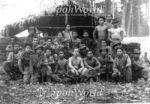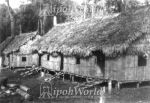We've tried to ensure the information displayed here is as accurate as possible. Should there be any inaccuracies, we would be grateful if you could let us know at info@ipohworld.org . All images and content are copyright.
(Please click on the thumbnail for a bigger image.)
Fort Kemar - The Building Of A Malayan Jungle Fort - Part 7
Thumbnail :



Subject :Fort Kemar - The Building Of A Malayan Jungle Fort - Part 7
Published By : None
Location : Perak
Estimated Year : 1953
Media Type : Photograph
Source : Dennis Wombell, UK
Remark : By this time we had established an excellent relationship with the Orang Asli for whom I had both respect and admiration. They were the most primitive people I had ever met and they had the innocence of children. Very few of them had ever seen a vehicle, an aeroplane, a helicopter, a gun, an explosive or a white man, and witnessing their sheer awe at seeing these things for the first time was a joy. They had nothing which they did not make themselves from materials found in the jungle in which they lived, nor did they have any food which they themselves did not grow, catch or hunt and, because they had nothing, there was nothing to steal and because they were not violent there was no crime. They were, in short, a very happy unmaterialistic people on the other hand they were the masters of the jungle. Their hunting, trapping, fishing and tracking skills were unrivalled and they were marksmen with their blowpipes armed with poison darts. They were expert house builders and could navigate their bamboo rafts down the fiercest of rapids. The men wore only a small loin cloth and the women were bare breasted, but there was never even the slightest hint of immodesty. Happily, their presence was taken for granted by my men who behaved at all times with absolute propriety. It was sad that, eventually, the Aborigine Department in Kuala Lumpur could not accept this situation, and, having decided that our Orang Asli ladies should have their breasts covered, sent in, in one of our airdrops, a consignment of bras. Worn without a blouse, these made our pretty, innocent Orang Asli girls look like cheap cabaret girls and I ordered the bras to be collected and burnt! Those girls who wished to cover themselves above the waist and had no blouse, were perfectly able to do so in the manner to which they were accustomed, by folding their sarongs above their breasts.
Pretty well all living things were food to the Asli and the ladies were especially adept at catching rats. Their technique was to make a squeaking sound by sucking between a finger and thumb over an area of rat holes and to listen for the young rats` squeaking reply. Upon hearing from where the sound came, they would plunge a pointed stick into the ground and catch the rats in their hands as they ran out of the holes. They cooked them as they did all their meat, by throwing them onto a large fire, and, after scraping the burnt fur off the skin, would pick off and eat the meat. I occasionally took large groups of the men down-river for a fishing trip, using, I am now ashamed to say, explosives. These were either in the form of a couple of sticks of our C-3 plastic explosive with a lighted fuse or a hand grenade. Either of these, thrown into a large deep pool would result in the eruption of hundreds of dead fish floating on the surface to be collected by the hoardes of cheering, screaming Asli men and children leaping into the river to scoop up baskets of fish. I had a slight problem with the hand grenades which had two types of fuse, one which detonated the grenade 5 seconds after throwing it, and the other a 7 second fuse which enabled the grenade to be fired from a rifle attachment and required the extra 2 seconds before exploding. Unfortunately, when we ran out of 5 second fuses, I found that the 7 second fuse frightened the fish away before exploding. My technique in this case was to pull out the pin of the grenade, and, holding it fizzing in my hand, count upto three before throwing it. This technique was successful, but decidedly unpopular with those in my immediate vicinity who were inclined to disappear behind trees until they heard that the grenade had exploded in the river and not in my hand! These fishing days, seen as rest days, were days for great celebration and not a great deal of work was done by either my men or the Asli, all of whom gorged themselves on the most delicious fresh fish - manna from heaven for the Asli!(Editor's note - the picture of the Orang Asli with their haul of fish may be found at Part 3 of this article
On the left is Dennis with his platoon. The photographs demonstrate what a great relationship had been established between the team and the Orang Asli (centre) as they take final photographs with their work on building the Fort effectively complete. On the right can be seen the first Barrack Blocks.
To go to Part 8, click here.
Pretty well all living things were food to the Asli and the ladies were especially adept at catching rats. Their technique was to make a squeaking sound by sucking between a finger and thumb over an area of rat holes and to listen for the young rats` squeaking reply. Upon hearing from where the sound came, they would plunge a pointed stick into the ground and catch the rats in their hands as they ran out of the holes. They cooked them as they did all their meat, by throwing them onto a large fire, and, after scraping the burnt fur off the skin, would pick off and eat the meat. I occasionally took large groups of the men down-river for a fishing trip, using, I am now ashamed to say, explosives. These were either in the form of a couple of sticks of our C-3 plastic explosive with a lighted fuse or a hand grenade. Either of these, thrown into a large deep pool would result in the eruption of hundreds of dead fish floating on the surface to be collected by the hoardes of cheering, screaming Asli men and children leaping into the river to scoop up baskets of fish. I had a slight problem with the hand grenades which had two types of fuse, one which detonated the grenade 5 seconds after throwing it, and the other a 7 second fuse which enabled the grenade to be fired from a rifle attachment and required the extra 2 seconds before exploding. Unfortunately, when we ran out of 5 second fuses, I found that the 7 second fuse frightened the fish away before exploding. My technique in this case was to pull out the pin of the grenade, and, holding it fizzing in my hand, count upto three before throwing it. This technique was successful, but decidedly unpopular with those in my immediate vicinity who were inclined to disappear behind trees until they heard that the grenade had exploded in the river and not in my hand! These fishing days, seen as rest days, were days for great celebration and not a great deal of work was done by either my men or the Asli, all of whom gorged themselves on the most delicious fresh fish - manna from heaven for the Asli!(Editor's note - the picture of the Orang Asli with their haul of fish may be found at Part 3 of this article
On the left is Dennis with his platoon. The photographs demonstrate what a great relationship had been established between the team and the Orang Asli (centre) as they take final photographs with their work on building the Fort effectively complete. On the right can be seen the first Barrack Blocks.
To go to Part 8, click here.
Filename : 20111204-022